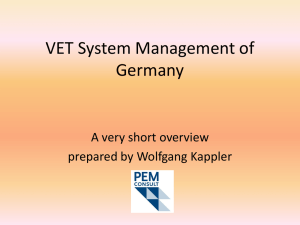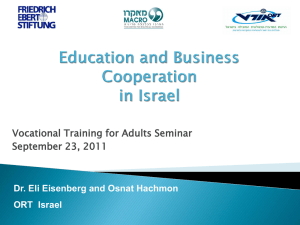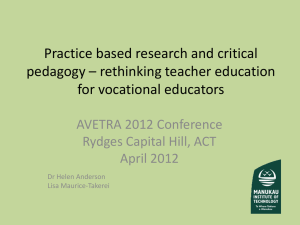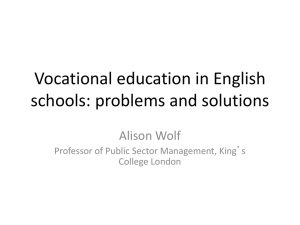The Role of Vocational Pathways and Qualifications in Enabling
advertisement
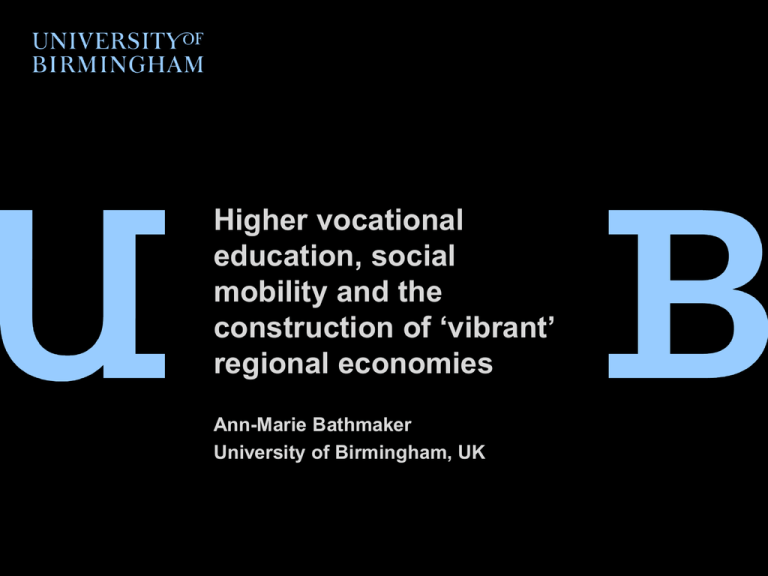
Higher vocational education, social mobility and the construction of ‘vibrant’ regional economies Ann-Marie Bathmaker University of Birmingham, UK Overview Shifting policy interest: higher vocational education (HIVE) instead of higher education for certain types of learners The international context: growing interest in HIVE Levers that shape qualification pathways HIVE in England: the meaning of HIVE the challenges facing HIVE in the English context College for All: the wrong policy goal? Challenges to ‘College for All’ policy in the US … mounting evidence that the college-for-all model isn't working. Nearly half of those who start a four-year degree don't finish on time; more than two-thirds of those who start community college fail to get a two-year degree on schedule. Even students who graduate emerge saddled with debt and often without the skills they need to make a decent living. (Los Angeles Times, 3.12.13) Challenges to HE widening participation policy in England For many individuals and for the country there may be more to be gained from vocational education in FE – which is in many respects, the area where we will tackle some of our key deficits as a country in intermediate skills. Apprenticeships rather than degree courses? [….] The reality is that our best FE colleges and advanced apprenticeships are delivering vocational education every bit as valuable for their students and the wider economy as the programmes provided by universities. [….] [T]here could be a law of diminishing returns in pushing more and more students through university. (Vince Cable, 2010) But at the same time: policy backing for higher vocational education in England We will develop and promote the concept, identity and value of our ‘Higher Vocational Education’ portfolio with clear, flexible and articulated progression routes into Levels 4, 5 and 6. (BIS 2011: 13) ‘Higher vocational education’ as a distinctive form of education and training provision, to be promoted, in the UK BIS Further Education and Skills System Reform Plan Higher vocational education Policymakers in England claim HIVE (through HE in Further Education colleges) will contribute to regional economies: HE in FE offers local, accessible, flexible and vocational forms of higher education to adults and young people from a range of educational and social backgrounds HE in FE offers locally-relevant, vocational higher-level skills such as HNCs, HNDs, Foundation Degrees and Apprenticeships (Parry et al, 2012) However, higher vocational education does not feature in current regional economic strategies. HIVE and social mobility Policymakers in England also claim HIVE will contribute to social mobility. However, higher vocational education does not feature in the work of the UK’s Social Mobility and Child Poverty Commission, which has paid particular attention to the role of education in relation to social mobility. What does the Commission say? …about HIVE and social mobility … in contrast to …. … about vocational education and social mobility Public policy has for decades focused on university education, not the ‘other 50 per cent’ who go on to take vocational education or work, and who face lower funding and greater complexity in their choices. The UK has longstanding problems in building a vocational route that is high volume, and commands parity of esteem with academic pathways. Whereas countries like Germany and Australia accord high status to vocational education and apprenticeships as a route into employment, the UK has placed its bets on higher - rather than vocational routes. (Social Mobility and Child Poverty Commission, 2013: 23) … about university HE and social mobility New research shows that there is a problem at the bottom end of the professional career ladder. Take two students with the same prior attainment, subjects and university: three years after graduation, the one from an advantaged background has a higher chance of being in a top job than the one from a disadvantaged background. The class effect is bigger than the gender effect. The top professional jobs are still more likely to go to men from a private school and privileged background. The hope that the phenomenon of a social elite dominating the top jobs would fade over time seems misplaced. (Social Mobility and Child Poverty Commission, 2013: 26-27) International interest in HIVE In the 21st century, knowledge-based human capital is deemed essential for competitiveness in globalised economies One of the crucial challenges is the question of whether to invest in general post-secondary education or in specific vocational training. (Powell and Solga, 2010) Higher education has become regarded as a critical ‘motor’ for national and regional competitiveness in the global economy, and a global battle has begun for the minds and markets to support this. (Robertson, 2008) Why is HIVE important now? Patterns and trends across Europe and OECD countries Transitions have become more prolonged, more differentiated, less linear and less predictable. Processes of differentiation and selection formerly associated with secondary education are increasingly associated with higher education. (Raffe, 2013: 9) Patterns and trends across Europe and OECD countries (2) Levels of participation and attainment in education have risen The average age of entry to the full-time labour market has risen HE graduates have maintained or increased their relative advantage (if not their absolute position) in the transition process Unqualified school leavers, despite the decline in their numbers, continue to suffer the greatest disadvantage Children of working-class or unemployed parents, migrants and ethnic minority groups are disadvantaged; even when they perform well in education their gains may not carry forward into the labour market. Females have overtaken males in terms of educational attainment but they experience less favourable labour-market outcomes than males. (Raffe, 2013: 9) In England: Experience of transitions and education and training pathways are more individualized (Furlong and Cartmel) Routes are more complex and less clear (IPPR, 2013) There is an increasing ‘competitorization’ of the self (Bates and Riseborough, 1993) Supra-national shaping and steering Shapes thinking about educational pathways suggests normative models of appropriate pathways Organisation for Economic Co-operation and Development (OECD) Steering through multi-national country reviews: 1 2 3 Review of tertiary education policy (2004-2008) Review of initial VET (2007-2010) Review of postsecondary VET (2012-ongoing) The European Union Shaping and steering through The European Qualifications Framework (28 EU member states) The European Higher Education Arena (47 countries) These structures are used as: Mechanisms of alignment Mechanisms for reform Mechanisms to gain market advantage in a globalised education market Growing interest in the HE-VET nexus Research in Europe suggests a distinction between a) Anglophone approaches that privilege general academic education with learning on the job for VET provision, and b) a diverse range of European models that suggest vocational education, including higher vocational education is valued, has social prestige and offers labour market prospects (Graf, 2013; Powell and Solga, 2010) Hybridization: Germany, Austria, Switzerland Germany dual study programs Austria berufsbildende höhere Schule (higher vocational school with higher education entrance qualification) Switzerland universities of applied sciences that directly build on dual apprenticeship training and a vocational baccalaureate. Germany: dual study programmes Dual study programs combine in-company work experience with tertiary studies at vocational academies (Berufsakademien), cooperative universities (Duale Hochschulen), universities of applied science, or universities. That is, there are always at least two learning environments. Furthermore, in dual study programs, students and firms are bound by a training, part-time, practical training, or internship contract and students earn a salary. Dual studies are usually offered at Bachelor degree level. Austria: berufsbildende höhere Schule (BHS) The BHS takes one year longer than the general academic schools to complete. It offers a five-year course that is open to everyone who has successfully completed the eighth school grade. The BHS leads to a double qualification, namely an academic baccalaureate and a VET diploma. The academic baccalaureate provides access to HE, while the VET diploma grants the right to exercise higher-level occupations. After three years of relevant professional experience, graduates from the BHS of engineering, arts and crafts and the colleges of agriculture and forestry can apply for the title “Engineer” (Standesbezeichnung Ingenieur). Switzerland: Universities of Applied Sciences Designed for vocationally trained people, and legally obliged to be practice oriented. They are directly linked to dual apprenticeship training via the vocational baccalaureate. The Swiss vocational baccalaureate, which is regarded as the ideal path (“Königsweg”) into a Swiss university of applied sciences, builds a bridge between dual apprenticeship training and universities of applied sciences. Together, the university of applied sciences, dual apprenticeship and vocational baccalaureate combines learning processes from both VET and HE and links uppersecondary VET with post-secondary HE High value HIVE Graf (2013) says of the German, Swiss and Austrian hybrid models: They also signify a new premium sector, for example in terms of social prestige and labor market prospects. [….] This is mainly because they build on a level of parity of esteem between VET and HE that cannot be found in more school-based VET systems like in France or VET systems that are more oriented towards “learning-on-the-job” like in the UK or the US. Initial vs lifelong learning pathways Embedded in the above debates is a distinction between: Initial qualification pathways (Eraut, 2001) Lifelong learning pathways (Schuller and Watson, 2009) While these distinctions affect the role, purpose and value of HIVE pathways, there are also persistent educational inequalities through the lifecourse for particular groups of people What is meant by HIVE in England? ‘all sub-degree HE provision’ (Little et al, 2003: 3) which leads on to particular levels of occupation in the UK Standard Occupational Classification (2000 and 2010) - associated professional and higher technician occupations, which represent the third of eight groups in the occupational classification hierarchy HNCs, HNDs, Foundation Degrees, degrees, apprenticeships and professional awards, as well as ‘non-prescribed HE’ (BIS, 2011) offered mainly in English further education colleges full-time degree programmes, professional qualifications, vocational qualifications (including NVQs), higher apprenticeships and other bespoke qualifications (IPPR, 2013: 46) locally available, flexible and low-cost (£5,000 ‘fee only’ courses) These definitions include Different types of qualifications A variety of vocational education and training qualifications at levels 4 and above. These include some that are more rooted in occupational training, others in education; some that are two year ‘sub [Bachelor] degree’ qualifications (including two year foundation degrees), some that imply three year Bachelor degrees. Qualifications leading to particular levels in the occupational hierarchy ‘associated professional’ rather than ‘professional’ Provision that is offered by providers outside the English HE sector in particular provision in English further education colleges Provision that is local and low-cost Challenges for HIVE pathways in England Skills are not as important to employers as policymakers continue to claim Employers are not a homogeneous group and there are different labour markets, not one labour market One high-skills, knowledge-driven economy across the UK is an illusion There are few or no incentives from the labour market, through for example license to practise, for intermediate qualifications in particular. ‘There is some evidence […] that good, high-paying, high-skill jobs and low-paid, low-skilled work are both becoming more concentrated in certain localities, leading to a polarisation of the employment options facing some communities.’ (Pring et al, 2009: 141) The legacy of vocational education in England Most vocational qualifications have been gazumped by general educational qualifications that have higher selection value, and their relative esteem is self-perpetuating. (Eraut, 2001: 88) In this context Higher level vocational education can translate into Lower level higher education Key issues for future HIVE What does ‘higher vocational education’ need to look like in a context of increasing vertical stratification of the HE field? If vertical diversity is attractive, arousing emotions associated with ‘elite, excellence, quality’, which legitimises winners and stigmatises those not on top (Teichler, 2008), is it possible to develop ‘distinctive’ and valued higher level vocational education? What would be key features of higher level vocational education that ensure students are having doors opened, rather than being ‘cooled out’? Key features needed in HIVE The development of broad-ranging knowledge and skills in vocational streams: Vocational streams consist of linked occupations that share common vocational practices and knowledge base. Each vocational stream consists of a number of different occupations, and each occupation consists of a number of different jobs. Horizontal movement between occupations and jobs is possible, as well as vertical movement to higher skilled occupations and jobs. (Wheelahan, 2013) Key features needed in HIVE Links between HIVE and education for the professions that allow the possibility of progression from associate professional to professional occupations Strong engagement with employers locally as well as nationally that can establish the reputational value and credibility of HIVE qualifications Vocational pathways and qualifications, social mobility and the construction of ‘vibrant’ regional economies Paper presented at the ESRC HIVE-PED seminar at the University of Birmingham, UK on 23 June 2014 Ann-Marie Bathmaker University of Birmingham, UK School of Education, University of Birmingham, Edgbaston, Birmingham B15 2TT, UK a.m.bathmaker@bham.ac.uk References Bates, I. and Riseborough, G. (1993) Introduction. Deepening Divisions, Fading Solutions IN Bates, I. and Riseborough, G. (eds) Youth and Inequality, Buckingham: Open University Press, pp.1-13. Cable, V. (2010) A new era for universities. Oral Statement to Parliament. https://www.gov.uk/government/speeches/a-new-era-for-universities Accessed July 2012. Linda Croxford & David Raffe (2013) Differentiation and social segregation of UK higher education, 1996–2010, Oxford Review of Education, 39:2, 172-192. Department for Business, Innovation and Skills (2011) New Challenges, New Chances: Further Education and Skills System Reform Plan, London: BIS. Dewey, J. (2001 [1916]) Schooling for democracy, University Park: Penn State Press. Michael Eraut (2001) The Role and Use of Vocational Qualifications, National Institute Economic Review no 178: 88-98. Furlong, A. and Cartmel, F. (1999) Social Change and Labour Market Transitions in Ahier, J. and Esland, G. (eds) Education, Training and the Future of Work 1. Social, Political and Economic Contexts of Policy Development, London and New York: Routledge, pp.219-235. Graf, Lucas (2013) The Hybridization of Vocational Training and Higher Education in Austria, Germany, and Switzerland, Opladen, Berlin and Toronto: Budrich UniPress Ltd. www.barbara-budrich.net http://dx.doi.org/10.3224/86388043 Accessed 10 January 2014. HEFCE (2013) Destinations of leavers from higher education in further education colleges. Key findings: leavers up to academic year 2010-11. Annex C Supplementary Tables. http://www.hefce.ac.uk/media/hefce/content/pubs/2013/201301/Main%20report%20with%20Annexes%20A%20and%20B.pdf and http://www.hefce.ac.uk/pubs/year/2013/201301/name,76281,en.html Accessed 10 January 2014. Institute for Public Policy Research Commission on the Future of Higher Education (2013) A Critical Path. Securing the Future of Higher Education in England, London: IPPR. Brenda Little, Helen Connor, Yann Lebeau, David Pierce, Elaine Sinclair, Liz Thomas, Karen Yarrow (2003) Vocational higher education – does it meet employers’ needs? London: Learning and Skills Development Agency. Gareth Parry, Claire Callender, Peter Scott and Paul Temple (2012) Understanding Higher Education in Further Education Colleges. BIS Research Paper number 69, London: Department for Business, Innovation and Skills. Pring, R., Hayward, G., Hodgson, A., Johnson, J., Keep, E, Oancea, A., Rees, G., Spours, K. and Wilde, S. (2009) Education for All. The Future of Education and Training for 14-19 year olds, London: Routledge. David Raffe (2013) Explaining national differences in Education-Work Transitions, European Societies, DOI: 10.1080/14616696.2013.821619. Reay, Diane (2011) Schooling for Democracy: A Common School and a Common University? A Response to “Schooling for Democracy”, Democracy and Education, 19, 1: 14. Reay, D., David, M.E. and Ball, S. (2005) Degrees of Choice. Social class, race and gender in higher education, Stoke on Trent: Trentham Books. Social Mobility and Child Poverty Commission (2013) State of the Nation 2013: Social Mobility and Child Poverty in Great Britain, London: The Stationery Office. Teichler, U. (2008) Diversification? Trends and explanations of the shape and size of higher education, Higher Education, 56, 3: 349-379. Wheelahan, Leesa (2013) The weak link between education and jobs. Bridging the Divides: Transitions from secondary to tertiary and into employment. Paper presented in Auckland on 2-3 July 2013. An expansive vision for HIVE There is a danger that vocational education will be interpreted in theory and practice as trade education: as a means of securing technical efficiency in specialized future pursuits. Education would then become an instrument of perpetuating unchanged the existing industrial order of society, instead of operating as a means of its transformation. The desired transformation is not difficult to define in a formal way. It signifies a society in which every person shall be occupied in something which makes the lives of others better worth living, and which accordingly makes the ties which bind persons together more perceptible—which breaks down the barriers of distance between them. (Dewey, 1916/2001, p.325)


